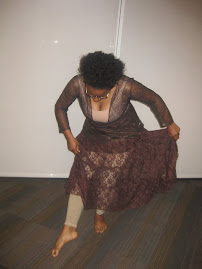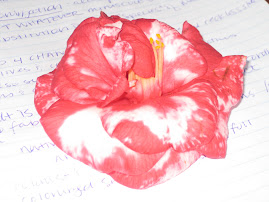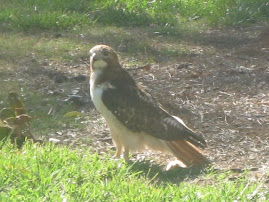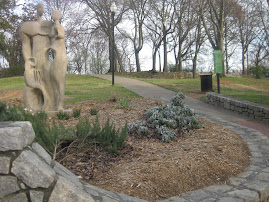A.Walker: Everyone must have a practice.
When I think of the precious beautiful things I have to be grateful for in every light of life. It thrills me and it brings me closer to that part of life:)
I'm grateful to share this with you all.







Read: In chapters 17 and 18, Haynes talks about the importance of knowingone's values and the various factors that contribute to an individual knowing who she or he is. She says, "...I have felt for some years that perhaps the greatest contribution I could make at this historical moment would be to act as steward of a small parcel of land. To care for a patch of earth and to learn from it. Not to begin by stripping the land bare and starting over, but by observing the seasonal rising and falling of the creek, the flight of birds, and the budding, flowering, and dying of weeds. This has become part of my artistic creativity." What similar kind of contribution might you make in your own life?
Resp: Who Am I? I am a beautiful living creation, one who is growing and doesn't understand it all and is not sure that I will ever have the goal of understanding it all, yet to understand myself enough to go after all I can in life is a real enough reality to me--to who I am. My values stem from treating people and the world the way I'd appreciate being treated to giving all I can to what's good and living and loving. My greatest contribution is to give of myself, It is who I am!! I love giving; building and sustaing myself enough to give to others-the world- and those closest to me. I'd love to give in a way that directly and indirectly affects people in a dynamic way; directly to most effectively allow change and development in one's life, indirectly to in a manner that may give opportunities to many- regardless of the direct contact I'm able to make. As for time, time has revealed itself to me as a friend, who is always there, keeping up with things and completely giving. Giving just enough to refelct and savor while pushing you right along to where you need to be, when you need to be there. I must appreciate it for all it is, appreciate if for all that it is and allows and gives and regulates; giving enough to appreciate and understand choas or things misunderstood, time is given to release a need for understanding or provide an ability to form an understanding. Time is able to remind us of its great treasure, as its present(s) are revealed as short so that we will savor and receive the best from all moments. As long as we treat time well, acknowledging it, realizing and being aware of it’s beauty, we will be more in love with it and allow our lives to be more shaped to its purpose. We must sew into time as we do nature and peace and love.
Revel: I really appreciate Charlotte's message of the best thing she can give the world, herself! This is so true and it was such a wonderful epiphany to me! when I first found this truth and this truth found me! I feel that I found it most applicable about two years ago, although it has developed over the years:). The funny thing is that these truths can sometimes escape you if you don't have wonderful reminders, or a community of reminders made available by this group of contemplative practicers! I appreciate the fact that me, all of who I am, is so incredibly unique and admirable in its own humble loving way that I must share myself to the world; and as I spoke so honestly of my desire to give to others, just as my sister has mentioned in her closing, I know that this truth is the greatest way to go about giving. Giving of all that you are and reasonably nothing that you are not! Thanks for the reminder and reinforcement:)!
~~~~~~~~~~~~~~~~~~~~~~~~~~~~~~~~~~~~~~~~~~~~~~~~~~~~~~~~~~~~~~~~~~~~Read: In chapter two of Art Lessons, what does Deborah Haynes say about learning that can help you in your form of artistry? How might you apply her five suggestions in your field?
Resp: Deborah Haynes begins her chapter with a quote that describes Aesthetic education as meaning to become a citizen of the world... I believe this is ever so true. She closes her chapter on the Balinese culture and M.C.Richcards ideals that art is basically not present at all, in that all that is to be created is to be done in it's best quality and therefore nothing is decipherable or that living and being is all of one's living. To me, this screams that Art is all or none of what we live-it is sacred~that word transcends again. Haynes charges us to trace our urge to artistry back and record it and develop it in the since that we've decied to proceed in our art. I appreciate this profoundly as I am made aware of self discovery in the claim to artistry. Finally, with the very well described crucial ingredients in aesthetic education, “Learning to write, developing a relationship to a sustaining tradition (giving breadth to yoru study of cultural traditions), undertake training in order to know your materials and to attain technical skills (using it again & again), becoming cognizant of and entering into dialogue with contemporatry cultural theory, and finally thinking of the question of one’s audience. The most personal aspect of these suggestions is the first writing one. I write indefinitely in a journaling, poetic style just to express myself and understand my thoughts a bit more-the means in which she described this as essential to one’s art and ones sense of self was very reassuring for me and I will apply it to my art as much as I can. I really appreciate the idea of studying a breadth of sustainable traditions also because it’s important to consider foundations… and allow breadth in order to expound on those traditions—therefore allowing creativity and concreteness all the same. I thought less of the current culture and considering the audience, yet appreciate her reminder of this. In closing I love her understanding of seeing one’s art as a gift to others and considering what you want one to gain from the gracious gift you are offering—with no expectations of gratitude or returned assets—just a gift of your passion and pride. The five words that she ends us with being “intention, concentration, discipline, perseverance, and will” are the most important “5 suggestions” that I feel she ultimately offers. Thanks~April
Revel: I truly appreciated the exerpt by Allison where she speaks of the beauty of writing first in that she revealed a reality of the joy and discretion in personal writing, "express without being limited by discomfort of not sharing everything with others." It is often most important to reveal information to yourself before you disclose those puzzled thoughts to the world... I've found. The open mind statement is clearly described from how Haynes asks us to approach understanding sustaining traditions. I think that is so very important that we must recognize what has sustained; what has success in continuance if it is continuance that we are seeking while we must also be open and creative to new, forms of living. I was unaware of the focus on Parody and Appropriation in approaching the tradition, the paradox them has proven to reappear. Finally, I appreciated her expression on importance of target audiences in that, "It provides direction, because you know how relatable you can aim for an art," this is so true although I often think less of the audience and just explore what I know to be real but to think of ppl as guidance tools guiding you to the direction of getting your point across and based upon how how relatable you allow yourself and your art to be.
~~~~~~~~~~~~~~~~~~~~~~~~~~~~~~~~~~~~~~~~~~~~~~~~~~~~~~~~~~~~~~~~~~~
Read: In chapter one, Deborah Hay asks, "What if there is no space between where I am and whatI need?" She talks about lying in Shavasansa, the hatha yoga "corpse pose," and entering a space of acceptance. How does her experience relate to what you do -- or might do -- to help yourself let go of wanting and striving, and to simply be with what is?
Resp:Throughout Deborah Hay's work of "my body benifits in solitude" I immediately grew appreciation for her solitude in dance. My first true experience with becoming personal with dance was in solitude through a single piece that I choreographed to India Arie's "India's song" and as I explored this personal experience with dance, I learned more things about my unique approach to the art. I required dancing in the dark, or dimmed light and it did serve as a means of focusing almost as it is described in this piece. When Deborah Hay asks, "What if there is no space between where I am and what I need?" I believe that she is exploring the reality of our life as it is now. We have all that we need to be contempt, we have all that is necessary for peace and we have all that enables us a prosperous future. It is our ability to accept this that determines how we can come to the understanding and releif that, "Where I am is where I am." As she talks about lying in Shavasansa, or what she more commonly calls the "corpse pose," she describes the peace and oneess that she's able to obtain. I absolutelty appreciate her description of "inactive synapses" (as a bio major;). Her description of entering a space of acceptance relates to my experiences of taking long hot baths. When I am in the water, I could care less about anything but myself, my love for myself, my physical body and my love and adoration for all that I am. I fall in love with what is all over again and I am able to accept and feel pure, at ease, clean, refreshed and careless. I appreciate the corpse description because often I'll allow myself the same pose while bathing and I can free my mind of movement and matter. As Hay concludes the chapter with "I realize how much I hold on to life," I agree with my similar methods using the "chemistry of life: water" that what's wonderful of life is revealed when you practice something that allows you to look inside, see above or allow your head to hang below... say, a pool of hot water.


No comments:
Post a Comment